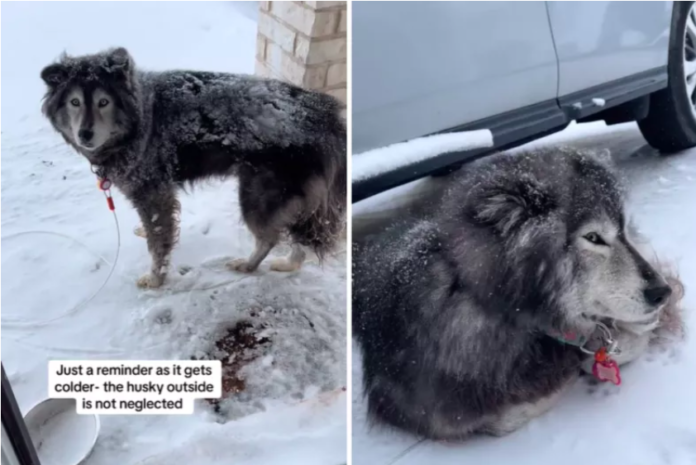Last Updated on November 17, 2024 by Fumipets
Owner Defends Leaving Siberian Husky Out in the Snow: ‘Not Neglected’
The internet has rallied behind the owner of a Siberian husky after she defended her decision to let her dog play outside in a snowstorm. In a TikTok video, Laura Stanton, who shares her adventures under the username @kodanfriends, showcased her husky, Koda, embracing the snow in her natural element. Despite concerns from viewers, Stanton made it clear that her beloved pet was far from neglected.
A Viral Video Sparks a Conversation
The TikTok clip begins with Koda enthusiastically tugging at her leash, eager to venture into the snowy outdoors. Stanton, her owner, attempts to coax her back inside, only for Koda to lie stubbornly on the ground, making it evident that she’s not ready to give up her winter wonderland.
“Just a reminder as it gets colder—the husky outside is not neglected,” Stanton added in an overlay on the video. The video, filmed in New Mexico, highlights Koda’s love for snow, an affection shared by many huskies. It has since gone viral, garnering over 2.8 million views and 430,000 likes.
@kodanfriends 5 minutes turned into 30 seconds… of my dog ignoring me. #husky #snow #cold
Huskies and Their Natural Affinity for Cold Weather
Siberian huskies are bred for cold climates. With their thick double-layered coats, insulated paws, and sturdy build, they are equipped to thrive in snow and icy conditions. A Dogster article notes that huskies are far more comfortable in freezing temperatures than they are in hot weather, where overheating becomes a concern.
“Before owning Koda, I would have been worried about a dog outside in a snowstorm,” Stanton explained. “Now I know better. She’s happiest out there.”
What Makes Huskies Snow-Proof?
- Double Coat: A dense undercoat traps heat, while the outer layer repels snow and moisture.
- Snow-Proof Paws: Their paw pads are designed to handle icy surfaces without discomfort.
- Fluffy Ears: These help minimize heat loss.
- Endurance: Huskies are built for pulling sleds across snowy terrains for miles.
The Importance of Knowing a Husky’s Limits
While huskies are cold-weather champions, their owners must remain vigilant about potential risks. Veterinarian Jess Kirk, in an article for Vet Explains Pets, highlights that while huskies love the cold, prolonged exposure to temperatures below minus 7°F can lead to frostbite or hypothermia.
- Daily Exercise: Regardless of weather, huskies need regular activity.
- Signs of Frostbite: Look for discoloration or swelling in the ears, paws, or tail.
- Monitoring Time Outside: Even snow-loving dogs need breaks from the cold.
A Responsible Pet Owner Speaks Out
Stanton emphasized that Koda is not left outside overnight and always comes in to sleep. However, during the day, Koda’s snow escapades are her choice.
“She really does look sad when she’s covered in snow, but that’s when she’s happiest,” Stanton said.
This message resonated with many husky owners who shared similar experiences. One commenter noted, “I begged my husky for hours to come in, but he made a snow bed and wouldn’t budge.”
Social Media Reactions
The viral video received thousands of comments, with most viewers siding with Stanton and praising her understanding of her dog’s needs.
- User Mel: “He probably wants you to close the door because you’re letting the heat out.”
- Chelsea: “I’m more concerned when people leave huskies outside during 90°+ summer days.”
- Bianca Lorrin: “Karen, my neighbor, gave me a speech on caring for dogs because my husky wouldn’t come in from the snow!”
These comments reflect a shared understanding among husky owners about their pets’ unique preferences and needs.
Huskies and Hot Weather: A Greater Concern
While the cold is huskies’ comfort zone, summer heat poses a significant challenge. Without proper care, huskies can quickly overheat in warm climates. Responsible owners must ensure their pets have access to shade, cool water, and limited exposure to direct sunlight.
Conclusion
Laura Stanton’s story serves as a reminder of the importance of understanding a pet’s breed-specific needs. Huskies like Koda are built for the cold and often thrive in snowy conditions. While concerns about neglect may arise, it’s evident that Koda is a well-loved and cared-for companion enjoying her natural habitat. As with any pet, balancing their happiness and safety is key.
FAQs
1. Can Siberian huskies live outside in the snow?
Yes, huskies are bred for snowy conditions and have a double coat that keeps them warm. However, prolonged exposure to extreme cold should be avoided to prevent frostbite or hypothermia.
2. How can I tell if my husky is too cold?
Signs include shivering, lethargy, or lifting paws off the ground. If you notice these symptoms, bring your dog indoors and warm them gradually.
3. What temperature is too hot for a husky?
Huskies struggle in temperatures above 70°F. Ensure they have access to water, shade, and cool surfaces in hot weather.
4. Are huskies more prone to frostbite?
No, but they are not immune. Frostbite typically affects extremities like paws, ears, and tails when exposed to temperatures below -7°F for extended periods.
5. How much exercise does a husky need in winter?
Huskies require regular exercise, even in cold weather. Aim for at least an hour of physical activity daily.
References: Original Newsweek Article


















